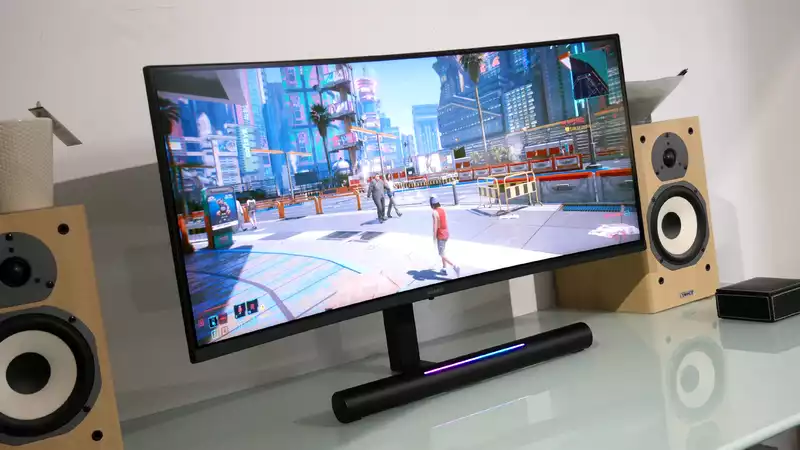It seems like we've seen it all before when it comes to 34-inch 1440p ultrawidescreens running at gamer-friendly refresh rates. Therefore, the Huawei MateView GT has to work to stand out from the crowd, pushing aside existing popular products like the MSI MPG Artymis 343CQR. There are plenty of competitors.
Of course, Huawei absolutely has the resources to come up with something special, and the £499 MateView GT is definitely not a cookie-cutter monitor. It does different things. For starters, its design and engineering are on another planet. With its gorgeous alloys, integrated soundbar, and funky RGB lighting, it's much better built than your typical plastic gaming monitor.
That said, these things are not necessarily central to a good gaming experience. But at least the pricing has not gone up. The MateView GT with soundbar is attractively priced at £499 in the UK (so far, it is not available in the US.) Regardless, what is more important is the panel's specifications and performance. Again, mostly good news here.
As is customary for a 34-inch, it has 3,440 x 1,440 pixels and a 21:9 aspect ratio. Like many competing panels, the MateView is curved, in this case with a radius of 1500R. While not as extreme as the 1000R curve of the aforementioned MSI MPG Artymis 343CQR, you will definitely notice it.
As for panel technology, this is a VA model. As such, it has the usual pros and cons against IPS alternatives. On the positive side, the contrast is 4,000:1, which is the highest static contrast for an LCD monitor and much better than the 1,000:1 or 1,300:1 of a typical IPS monitor. It is far superior to the 2,000:1 of the new class of IPS panels recently announced.
HDR performance bodes well, given that this panel does not have a fancy miniLED backlight; the Huawei MateView GT supports HDR10 signal processing but does not have local dimming of any kind. However, the panel's inherent contrast at that level promises above-average HDR performance for a screen without dimming, even with a brightness rating of 350 nits. We'll find out sooner or later. Incidentally, Huawei claims the MateView GT's color accuracy to be 90% coverage of the DCI-P3 digital cinema space. This is OK, but certainly nothing special.
A drawback of VAs is often pixel response. Huawei claims 4ms, which is too slow in the context of gaming. However, on paper pixel response specs rarely tell the whole story, so we'll reserve that thought. On the other hand, the MateView has a maximum refresh rate of 165 Hz, which is nothing special in this era of 360 Hz and higher panels, but also adequate for all but the very few gamers who need the lowest possible latency.
In any case, the proof is, as ever, in the looking. As for color and contrast, this is definitely a great panel. It packs enough punch and is very high contrast for a panel without local dimming. In fact, this is on par with the HDR experience you get without the trick miniLED backlight.
Nevertheless, the color balance and contrast of SDR content in HDR mode is a bit distorted (a very common problem with monitors that offer basic HDR support), so leaving the MateView in HDR all the time is not practical.
So what about these response figures?" Huawei offers four user-configurable overdrive levels in the OSD menu. They can also be turned off completely. None of these levels give us a pixel response performance that we are entirely satisfied with. Level 2 and below are quite blurry. Level 4, the fastest setting, is certainly sharp, but it produces some pretty nasty overshoot and ghosting. Level 3 is a bit blurry and smacks of overshoot, but is probably the best compromise.
There is no escaping the fact that pixel response is not this display's strongest suit. However, when you are actually in the game, as opposed to forensically examining test animations or moving windows around to look for problems, it is actually quite acceptable.
It depends on where you place your priorities. This type of display is not cheap, but still a compromise must be made. There are faster panels in this segment, including the MSI monitors already mentioned. But in that case, you will probably have to give up something else, such as MateView's outstanding contrast, gorgeous build quality, and megabucks looks.
To wrap things up, a couple of other minor issues are worth pointing out. The audio quality from the sleek soundbar is, after all, garbage. It is muddy, flat, and has almost no stereo separation; MateView can be purchased without the soundbar, but in that case the RGB lighting strip, which doubles as a touch panel to control various functions, is no longer available. While irrelevant to gaming, it is an intriguing element to own.
In terms of connectivity, in addition to DisplayPort and HDMI, the device has a USB-C interface that can also be powered, allowing for a single cable connection to a laptop. At least it would be if the power supply were not limited to a mere 10W. This is not enough to continue to provide adequate power to a thin and light laptop, let alone a portable gaming console.
Overall, the Huawei MateView GT is not a slam dunk as a pure gaming panel. The mediocre pixel response speaks for itself. However, as an all-around, do-everything screen that is great in terms of image quality and styling, especially considering its competitive pricing.
We like it, with a few caveats.
.

Comments